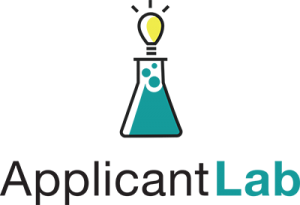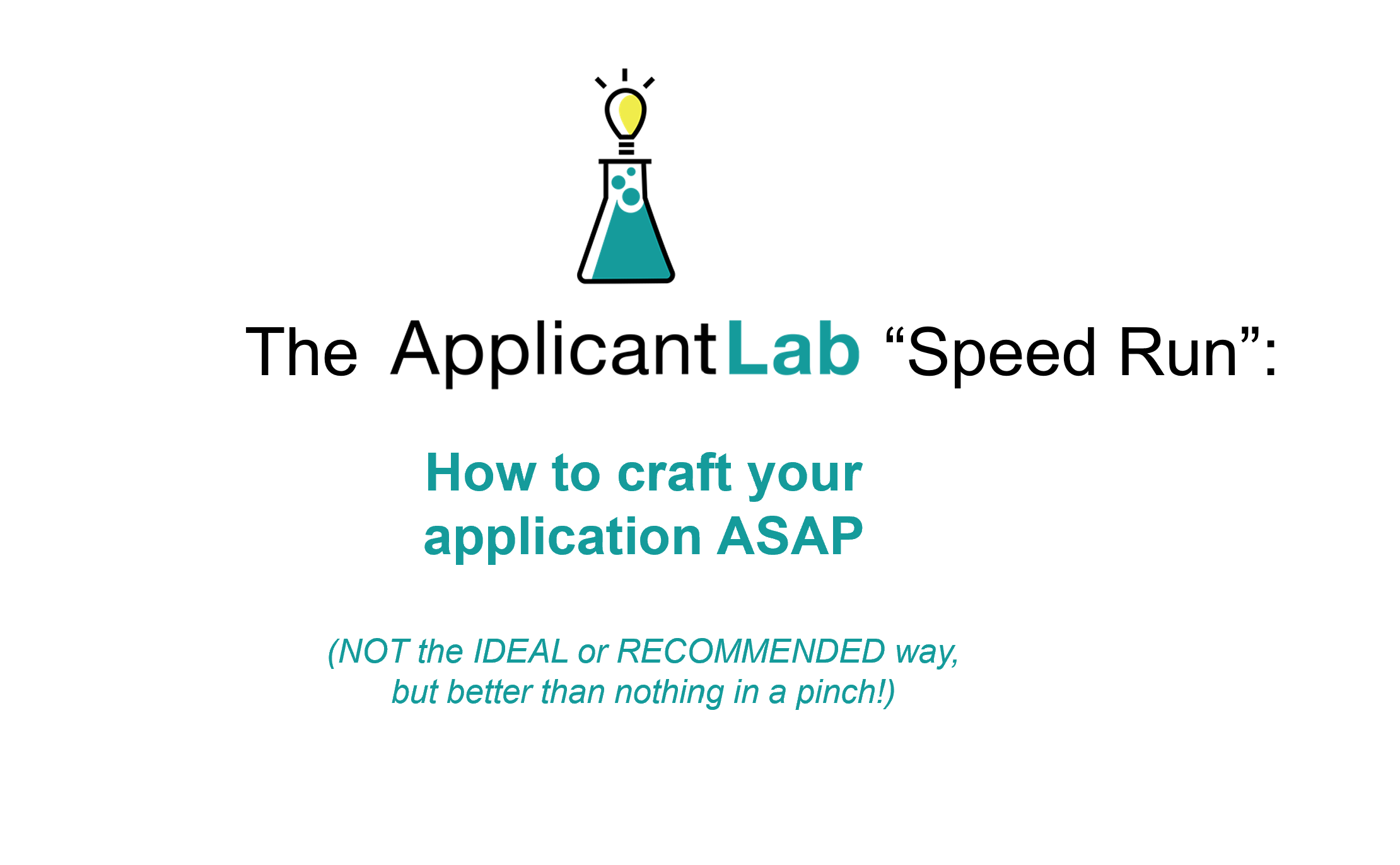Since ApplicantLab’s exercises and advice are available online 24/7, even the most rushed MBA candidate can use it to maximize their chances, with the limited time they have left!
In an ideal world, people would spend 6-12 months working on their applications, but SPOILER ALERT: we don’t live in an ideal world, and so here you are: maybe only a week or three left before a deadline, panicking.
Maybe you were derailed by a health issue. Maybe you were recently laid off and so applying to business school wasn’t even on your mind until last week! Maybe you didn’t know a whole lot about just how competitive (and complicated!) business school applications are, and you were a little cocky / didn’t think these essays would be challenging. Or maybe you just procrastinated!
So here’s how you can “speed run” your way through ApplicantLab, if you’re in a big hurry! (pssst! You can start your free trial right now, no credit card required!)
While this isn’t the ideal scenario, even if you can’t go through all of the advice I’ve got in the Lab, with these steps I can at least help you make some key last-minute course corrections so that what you submit ends up being as strong as possible, given the circumstances.
Here is a quick text list of the steps, followed by a video explanation (you can play the video sped up 2x!), and then below that a longer written explanation of the steps you will take in the Lab as part of your “speed run”. Note: this assumes that you’ve already got a strong resume in place (don’t forget that the resume is MORE IMPORTANT than the essays) (you can see some of my resume advice via the ApplicantLab free trial — just create your account and click through to get to the Resume module! Already upgraded? Click here to jump directly to the Resume module , where you can select “7. Your Checklist” as a quick way to check your own resume) AND that you’ve already prepared your recommender(s) to submit something for the upcoming deadline (that is, that they at least are on-board with supporting you and have agreed to be ready by the deadline).
- STEP 1: Skim the “Career Vision checklist” and “Why MBA checklist” items in the “To Do List” module
- STEP 2: Go to the “Brainstorming” module and use its prompts to come up with at least 3 Leadership stories and 1 Failure story per each recommendation you need (e.g. since most people need to submit 2 recommendations, brainstorm a minimum of 2 “Failure” stories).
- STEP 3: Branding [OPTIONAL] IF you are writing multiple schools’ essays (and / or if you’ve Brainstormed several possible stories) use the Branding module to allocate (at a minimum) the top 3 “Leadership Brand Traits” to your stories — this will help you filter through / prioritize the most promising stories later on.
- STEP 4: Jump to the “Pre-writing” module and use its mini-questions to beat writers’ block and make sure you’re hitting the right points. If at any point you’d like more in-depth explanation or analysis of a specific essay question, don’t forget that you can hit “Review Advice” to pop-up the additional insights… but if you’re really in a hurry, just follow the pre-writing prompts!
- STEP 5: Go back to the “To Do List” module, click on any school’s name, and review the advice in the “Rough Draft checklist” and the “Final Draft checklist” — apply those lessons as you build upon your pre-writing notes and start to flesh them out into a proper essay
- STEP 6: OPTIONAL STEP re: Recommendations: if you’re still in a position to influence what your recommender says about you, this might be a good time to check out the core advice in the “Recommendations” module, so that you can try to course-correct / persuade them to modify what they’re writing *IF* you realize after reading that module that you had asked them to write sub-optimal things about you!
- STEP 7: The Application Forms… Do NOT save these for the deadline day since there will probably be surprise text boxes to fill out — go through your forms, and then refer back to the advice in the Application Forms module for any that are particularly tricky (e.g. “Which other schools are you applying to and why?”, “Reason for leaving last job”, “Description of extra-curricular involvement”, etc.)
1. Since a weak “career vision” / “why I need an MBA” argument is the number-one reason otherwise strong candidates get rejected, go to the “To Do List” module, and pull up the “Career Vision checklist” and the “Why MBA checklist”
In these sections of the To Do List, I have summarized the key take-aways taught in those two modules (you can see some of the other sample To Do List items as part of the free trial, which you can get started with right now!)(you can also access a teeny sampling of the Career Vision module in the free trial as well)
You can expand the video play-back screen to “full screen” and see the check-list. If you want more information / explanation, you can watch the videos themselves. If you only have time to watch one video in this section, watch the SECOND video at the bottom of the page of the “Why MBA checklist” module called “Sanity Check”.
Don’t forget, that, as with all videos inside of ApplicantLab, you can increase the playback speed by clicking on the gear in the lower right-hand side of the playback screen, you can increase the playback speed, up to 2.0x the speed!
- Important note: above I said that this is the main reason an “otherwise strong” candidate does not get in… however, this does NOT flow in the OPPOSITE way: that is, a super-amazing career vision / why MBA reason will NOT help someone with a weak profile get accepted… nor does it guarantee acceptance for a strong candidate. It’s just the main way “people who were otherwise probably going to get in end up shooting themselves in the foot“, which is why I think it’s so important!
2. Go to the “Brainstorming” module and use its prompts to come up with at least 3 Leadership stories and 2 Failure stories.
This is the sort of “bare minimum” number of stories you’ll need for MOST MBA application essay sets, plus, for 2 recommendations. Of course, more is better!!!!! But you’re in a hurry!!!! 🙂
The TYPICAL business school application will ask you for at least one essay that goes beyond “career vision / why mba” — and usually, that essay topic will ask you (either overtly or indirectly) about a time you’ve been a leader. Also, most MBA applications ask for one (though usually 2) letters of recommendation.
You may, of course, discover that your specific school’s essay set has more / different requirements, but in my experience, an absolute minimum of 3 Leadership essays can get a candidate through lots of applications — though I’d urge you to try to have 5 – 7 stories total if applying to more competitive schools.
Therefore, Brainstorming at least 3 leadership stories should cover you for EITHER the schools that ask for , say, 1 main leadership essay, AND also will give each recommender fodder to use, since each recommender is usually asked to talk about at least one thing you did really, really well (and as we know from the AdCom Hierarchy of Needs, the “thing you did really, really well” should NOT primarily be an “IQ” thing like an impressive analysis, but rather an “EQ” thing, like leading others).
- Important note: ULTIMATELY, you WILL need more stories for the INTERVIEW, so at SOME point you might need to come back to this module and really flesh it out (if you’re applying to a school like Stanford GSB that asks for at least 4 leadership stories [sure, some of them are “optional”, but come on… it’s not ACTUALLY optional!!!], or a school like Ross where you can write an 100-word essay about a failure you encountered, etc.) but the guideline above is the “bare minimum” that can probably get you through a lot of schools’ complete written applications.
3. [OPTIONAL] IF you are writing multiple schools’ essays (and / or if you’ve Brainstormed several possible stories), consider taking a few minutes to go to the “Branding” module and adding in the 1 – 3 brand traits I teach as most associated with “Leadership” to the relevant stories.
If you’re ONLY applying to 1 or 2 schools, OR if you’ve only limited yourself to a few leadership stories in Brainstorming, then you can skip this.
The benefit of the “Branding” module is to — when you get to the essay-writing step — help you visually-identify which of your stories might be the best choice(s) for a specific essay question. It can help you prioritize / organize if you’ve got lots of potential stories to use, lots of essays to write, or both!
Since you’re in a hurry, you can focus primarily on allocating the “Top three leadership traits” I emphasize (these are the ones at the top of the traits box, in their own little section) — in a hurry, focus on those three as they are the three most important ones!
If you have a LITTLE more time, other Brand Traits beyond the “Big 3 Leadership” traits that are usually good would be something around mentoring / coaching others, since schools like to see “supportive” students
4. Jump to the “Prewriting” module (after you’ve added schools to your list, of course) — please, please try to at least open up the Essay analysis advice and read the “In a Hurry?” short-cut (or maybe even watch a video or two, at 1.5x+ or even 2x speed), but if you’re completely in a hurry, then this will have to do.
The “Prewriting” module takes the essay questions and breaks them down into “mini-questions”, or sub-questions. This helps defeat writers’ block (by giving you a small, easy place to start) and also helps ensure that you don’t miss anything vital (and sometimes I even re-warn you to NOT do certain things).
Read the “mini questions” and then JOT NOTES in the text box on the right-hand side (or in your own document someplace else)
You can still, within the Pre-Writing step, pull up the in-depth advice that was displayed in the earlier steps. IDEALLY, you would have had time to have the Essay Advice and Mapping steps build upon each other before getting to Prewriting, but also IDEALLY I would have won the Powerball lottery last month, so…. Please do try to pull up the essay analysis in the “Review Advice” button (it’s the light-blue button on the right-hand side of each question) and go through as much of it as you have time for. Pre-writing was never meant to be a stand-alone step, it was meant to follow you going through a process of learning how admissions officers think, what each school looks for, etc., so ideally you can try to review *some* of the essay advice, especially for the trickier essay topics or for schools that are harder to get accepted to!
5.Go back to the “To Do List” module, scroll down to any school, and review the advice for “Rough Drafts” and “Final Drafts” (no need to actually use those modules if you’re in a hurry)
For the love of all that is good upon this earth, do NOT think that since business school is “SCHOOL” that your essays should sound like SCHOOL essays. They should NOT. They should sound like a CONVERSATION from the REAL YOU.
Don’t try to use big words. It makes you unlikeable. And even worse is when people try to use big words that they don’t really understand, and so they mis-use the word — in that case, someone is unlikeable AND embarrassing, and MBA programs do NOT want to admit people who are EITHER one of those two things!
6. “Recommenders” module: skim the good examples and bad examples to make sure your recommender is saying the right stuff about you!
You have probably already gotten the process of getting recommendations underway, but… JUST to make sure that you have asked your recommenders to say the most USEFUL things about you (as with the resume, the sorts of things they might say to impress a future employer might be meaningless.. or even backfire!… for an MBA admissions reader!
So, go to the Recommendations module and click on the green-side tab to pop up the advice article called “Purpose of Recc?” — you can then SKIM the advice here to see if the sorts of things you’ve asked your recommender to say about you is indeed what they are writing. If you realize after reading this advice that you need to course-correct, reach out to your recommender(s) RIGHT AWAY and tell them that you realize that you didn’t mention this earlier, so of course they don’t need to change their recommendation if it’s already been written… but if there’s any chance they’d be willing to write about (good, MBA-relevant) example instead of (boring, high-IQ) example, that you’d really appreciate it!
It’s worth a shot — after all, maybe your recommender has procrastinated a bit too… and this might be a case where that works in your favor! 🙂
7. “Application Forms”: read through the actual forms; check out this module for any tricky or unexpected questions
DO NOT WAIT UNTIL THE DAY OF THE DEADLINE to go through the application form(s) for the first time. MOST application forms will have a TON of little text-box questions (e.g. “Describe your greatest accomplishments at work”; “Tell us about your most significant international experience”; “If your direct supervisor is not a recommender, please use this space to explain why”….). You do NOT want for the clock to be counting down 15 minutes to go before the deadline and you realize to your horror that there’s no way you can get the stupid little boxes all filled in in time.
SO!
Go through your schools’ application forms soon-ish. Since it doesn’t take as much “brain power” as other tasks, the filling out of the forms can be a nice quasi-break from the more mentally-demanding tasks above.
If you run into a text box that you’re not sure what to say (“What should I write in the box asking about my job responsibilities? Or the one asking me why I left a certain job? OR the section asking me to list all of the other schools I’m applying to? What do I put there?! Help!!!”) then check out the Application Forms module, since I cover the most common mini-questions there. In case you find a form field that you don’t see advice for the in the Lab, then email [email protected] with the specific question, and we’ll try to point you in the right direction!
Sign up for the ApplicantLab Free Trial now (no credit card required!) to check out just a small sample of the Lab’s features…
…and remember, at this late stage, the other admissions consultants of my caliber (HBS graduate; in my 20th year of giving admissions advice) are PROBABLY already fully-booked for the upcoming deadline, and are DEFINITELY going to charge you MUCH more than the cost of ApplicantLab (most consultants of my caliber are charging $450+ for just one hour of their time, and they tend to sell time in a block of a “two hour minimum”… if you find someone charging less than that, or with wide-open availability only a few weeks before a deadline, then there’s a chance that they have spare capacity open for a reason…so even if you DO end up hiring someone else, that’s awesome!!!! But… maybe, maybe also get an affordable “2nd opinion” from an expert like me via the Lab, just in case, for example, a larger firm dumps you off on one of their least-experienced / least-popular staff members!)
My promise to you is that, for less than the cost of one hour of hiring me, you will get dozens of hours’ worth of advice (which of course, you can play back at 2x speed, ha ha) about every facet of the application… and any questions not covered in the Lab, you can just reach out to us at [email protected] to get clarifications!



